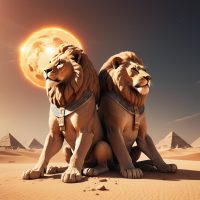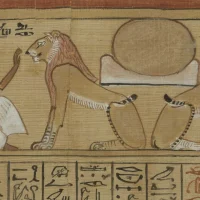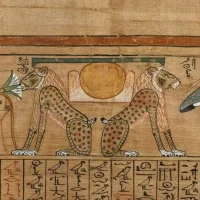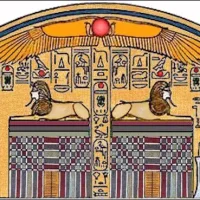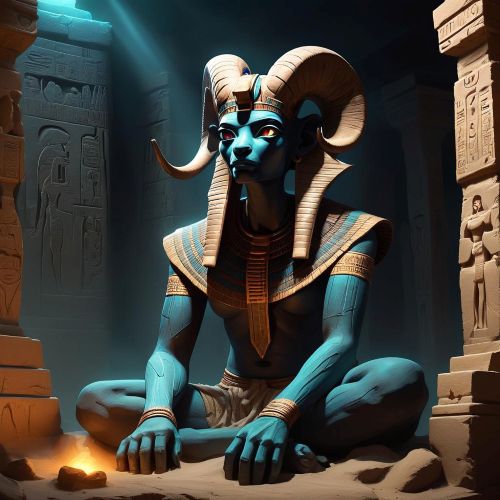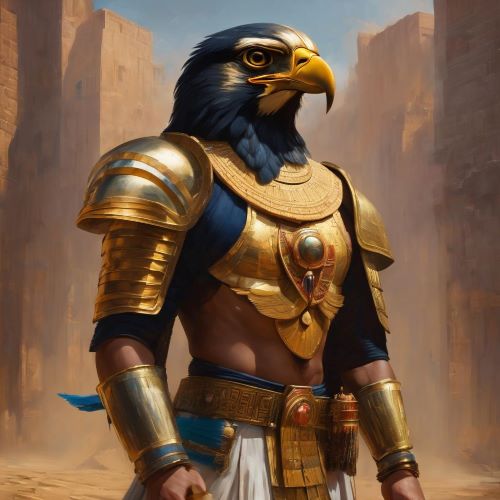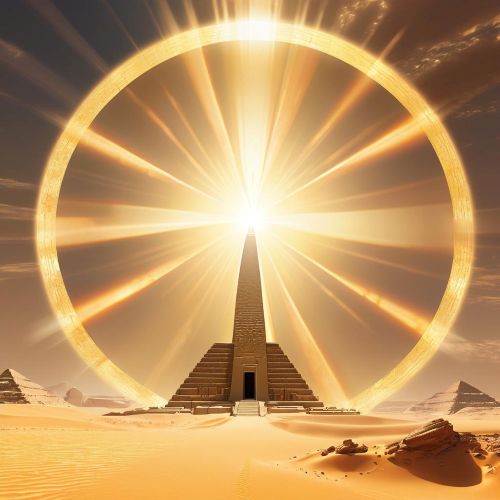Aker : God of the Horizon
Listen
At a glance
| Description | |
|---|---|
| Origin | Egyptian Mythology |
| Classification | Gods |
| Family Members | N/A |
| Region | Egypt |
| Associated With | Horizon, Sky |
Aker
Introduction
Aker is one of the most ancient deities in Egyptian mythology, representing the horizon and the boundary between day and night. First mentioned in texts of the Old Kingdom, he served as a cosmic guardian who ensured the safe passage of both the sun god Ra and the souls of the deceased through the perilous gates of the underworld. Unlike more prominent gods such as Osiris or Isis, Aker’s presence was subtle yet indispensable, symbolizing stability and protection against chaos. His role as the god of the horizon connected him not only to time and renewal but also to the cyclical balance that governed life and death. In Egyptian cosmology, the horizon was more than just a natural feature—it was a gateway to other realms, and Aker was its eternal sentinel.
Physical Traits
The imagery of Aker evolved throughout Egyptian history, but his most recognized form is that of two lions seated back-to-back, each facing opposite directions. One lion looks toward the east, embodying tomorrow and the promise of rebirth, while the other gazes westward, symbolizing yesterday and the passage into death. Between them often rests the “Akhet” hieroglyph, representing the horizon, with a solar disc rising or setting between two mountains.
Earlier depictions of Aker showed him as a single lion with an open mouth, and in some rare variations, as two sphinxes or as a strip of land ending in human heads. These designs reinforced his role as both a physical boundary and a divine force that separated and united past and future. The mountains linked to Aker were called Bakhu in the east and Manu in the west, believed to hold up the sky itself. While sculptures of Aker were uncommon, his imagery frequently appeared in tomb art, temple reliefs, and religious texts, highlighting his enduring symbolic power.
Family
Unlike many Egyptian gods who were integrated into elaborate divine genealogies, Aker stands apart as a primordial figure without clear familial connections. He is not mentioned as the offspring of Geb or Nut, nor does he form part of the Ennead or Ogdoad. Instead, Aker is considered an elemental deity, existing outside the framework of kinship and functioning as an embodiment of the earth’s horizon itself.
However, in some funerary texts, Aker is associated with other protective deities who safeguard the dead. He is often invoked alongside Geb, reinforcing his role as a guardian of the land. His relationship to Ra is functional rather than familial, ensuring that the sun god’s nightly journey through the Duat remains uninterrupted. This lack of family ties underscores Aker’s role as a cosmic principle rather than a personalized god.
Other names
Aker was also known by several alternate names that reflected his diverse roles. In plural form, he appears as Akeru, a class of earth deities mentioned in the Coffin Texts, often described as guardians who could restrain souls or defend the boundaries of the underworld. Another title, Ruti, meaning “the two lions,” highlights his dual nature and the temporal symbolism of yesterday and tomorrow.
The lions themselves were sometimes named Sefe (Yesterday) and Duaj (Tomorrow), directly tying Aker to the flow of time. Epithets such as “He Who Looks Forward and Behind” or “Guardian of the Gates” further emphasize his function as both protector and timekeeper. These names show the flexibility of Aker’s role in Egyptian religion, where he could be viewed as an individual god, a collective of spirits, or a symbolic representation of duality.
Powers and Abilities
Aker’s powers centered on guardianship, both of the physical horizon and the spiritual gateways between life and death. He was responsible for opening the gates of the eastern horizon each morning so Ra could rise, and closing the western horizon at dusk to allow the sun god’s descent into the underworld. In funerary traditions, Aker’s role was equally vital: he protected the deceased king from the venomous breath of serpents such as Hemtet and Iqeru, sealing tombs against demonic intrusions.
Texts from the New Kingdom describe Aker absorbing poison from the bodies of those bitten by snakes, linking him to healing practices as well. In the Book of the Earth, Ra’s solar barque is shown traveling across Aker’s back, symbolizing the horizon itself as the pathway of cosmic renewal. Aker was also credited with restraining Apophis, the serpent of chaos, ensuring that cosmic order was preserved. His guardianship extended not only to gods and kings but also to ordinary souls who invoked his name for safe passage into the afterlife.
Modern Day Influence
Though not as prominent as Osiris or Horus in modern references to Egyptian mythology, Aker’s symbolism continues to inspire both academic and cultural interest. His twin-lion imagery has been adapted into art, tattoos, jewelry, and architectural motifs, particularly as a symbol of protection and balance. The concept of facing past and future while standing firmly in the present resonates with contemporary mindfulness and philosophical teachings, making Aker’s imagery surprisingly relevant in today’s world.
In corporate and creative fields, Aker’s name has been adopted by organizations seeking to symbolize vision, stability, and the bridging of past experience with future potential. Museums and digital platforms also highlight Aker in exhibitions of Egyptian cosmology, introducing his imagery to global audiences. Beyond archaeology, Aker’s role as a guardian of thresholds continues to resonate in literature, psychology, and comparative mythology, where he is seen as a universal archetype of transition and protection.
Related Images
Source
Pinch, G. (2002). Handbook of Egyptian Mythology. Santa Barbara, CA: ABC-CLIO.
Hart, G. (2005). The Routledge Dictionary of Egyptian Gods and Goddesses (2nd ed.). London: Routledge.
Wilkinson, R. H. (2003). The Complete Gods and Goddesses of Ancient Egypt. London: Thames & Hudson.
Assmann, J. (2001). The Search for God in Ancient Egypt. Ithaca, NY: Cornell University Press.
Egyptian Museum Cairo. (2021). Aker: Guardian of the Horizons. Retrieved from http://www.egyptianmuseumcairo.com/aker
Tour Egypt. (2024). Mythological Gatekeepers: Aker and the Twin Lions. Retrieved from https://www.touregypt.net/aker.htm
Ancient Egypt Online. (2023). Aker: The God Who Guards. Retrieved from https://www.ancientegyptonline.co.uk/aker.html
British Museum. (2020). Aker in Egyptian Funerary Texts. Retrieved from https://www.britishmuseum.org/collection/object/aker
Frequently Asked Questions
What is lorem Ipsum?
I am text block. Click edit button to change this text. Lorem ipsum dolor sit amet, consectetur adipiscing elit. Ut elit tellus, luctus nec ullamcorper mattis, pulvinar dapibus leo.
What is lorem Ipsum?
I am text block. Click edit button to change this text. Lorem ipsum dolor sit amet, consectetur adipiscing elit. Ut elit tellus, luctus nec ullamcorper mattis, pulvinar dapibus leo.
What is lorem Ipsum?
I am text block. Click edit button to change this text. Lorem ipsum dolor sit amet, consectetur adipiscing elit. Ut elit tellus, luctus nec ullamcorper mattis, pulvinar dapibus leo.
What is lorem Ipsum?
I am text block. Click edit button to change this text. Lorem ipsum dolor sit amet, consectetur adipiscing elit. Ut elit tellus, luctus nec ullamcorper mattis, pulvinar dapibus leo.
What is lorem Ipsum?
I am text block. Click edit button to change this text. Lorem ipsum dolor sit amet, consectetur adipiscing elit. Ut elit tellus, luctus nec ullamcorper mattis, pulvinar dapibus leo.


